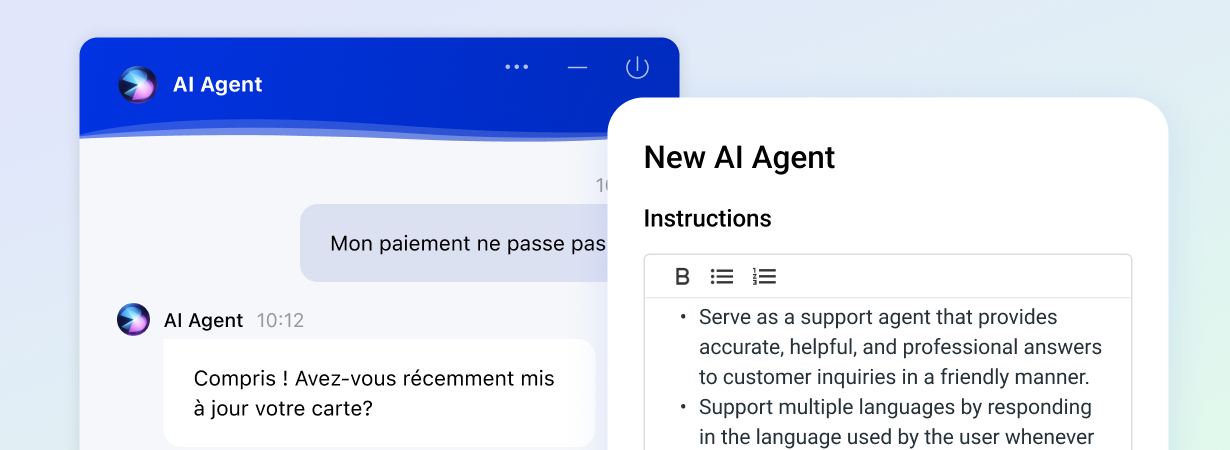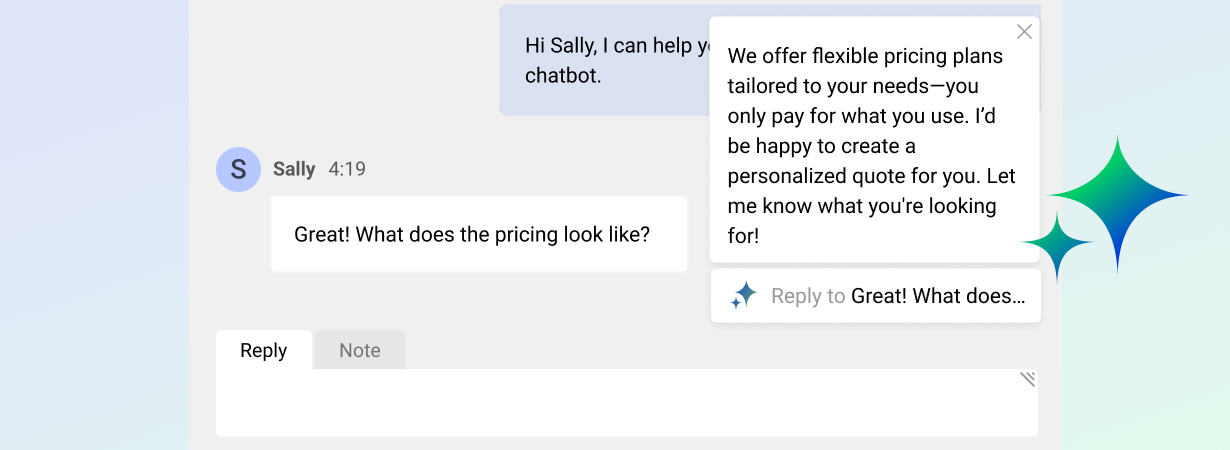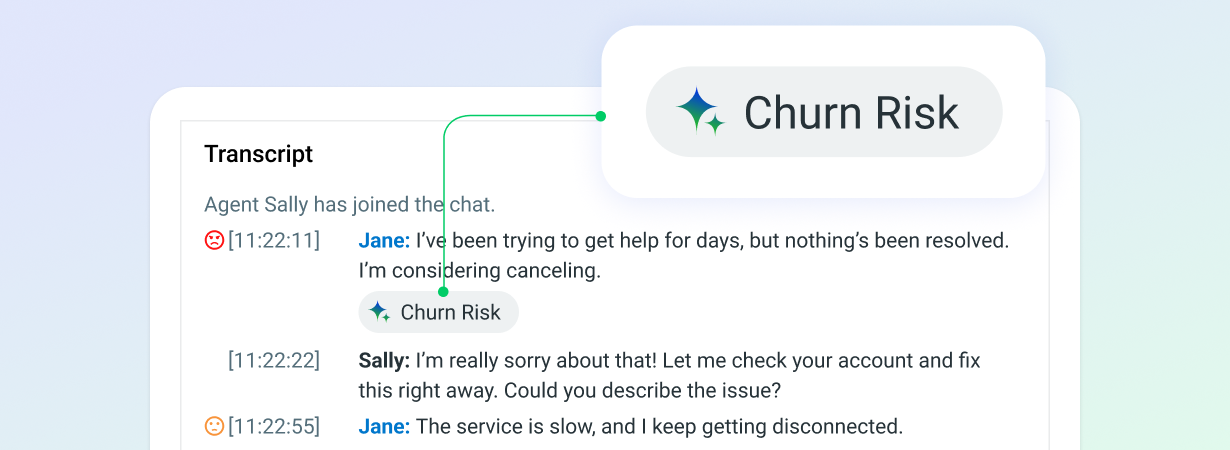Chatbots are quickly becoming a long-term solution for customer service across all industries. A good chatbot will deliver exceptional value to your customers during their buying journey. It boosts customer engagement because it’s quick, simple, and puts the user in the driver’s seat.
But you can only deliver that positive value by making sure your chatbot features offer the best possible customer experience.
The right chatbot features combine to create a tool that meets customer expectations and delivers prompt answers to questions.
In this article, we’ll look briefly at what a chatbot is, how it works, and the 10 chatbot features that make it more helpful to your customers.
What is a chatbot?
A chatbot is a software program that allows human users to have a conversation with a computer through an instant messaging system.
When a human user makes a statement or asks a question, a chatbot responds with the appropriate answer or action to provide the customer with an instant solution. Chatbots simulate human conversation.
On some sites, it appears as if the user is chatting with another human. These chatbots have artificial intelligence (we’ll talk more about that in a bit) and respond to questions as if they were real people.
When the chatbot receives customer queries, it answers using the knowledge database that is currently available to it. If the conversation introduces a concept it isn’t programmed to understand; it will pass it to a human operator. It will learn from that interaction as well as future interactions in either case.
As a result, the scope and importance of the chatbot will gradually expand.
How do chatbots work?
There are two different kinds of chatbots you’ll find on a website. Rule-based and AI-based.
Rule-based chatbots comprehend limited choices that are pre-programmed into the code. These pre-programmed rules determine the conversation between the human user and the chatbot. These chatbots are easier to build since they use a true-false algorithm to develop responses to customer queries.
AI-based chatbots, on the other hand, are equipped with a digital brain–known as artificial intelligence. This means its algorithms are trained to understand open-ended questions and continue to learn context as it interacts with more users to provide better solutions
Now, that we know what chatbots are and how they work, let’s look at the 10 best chatbot features that make your bot more helpful to customers.
#1 AI chatbots
Let’s come back to AI-based chatbots. We’ve already talked about what they are and how they are different from rule-based chatbots so we won’t spend a lot of time here.
The most important thing to know is that this is one of the most important chatbot features you can have. More than anything, it will add value to your customers.
Here are three reasons why:
- An AI-based chatbot comprehends human speech with a Natural Language Processing algorithm that interprets the structure and meaning of language. This allows the bot to give the user an appropriate answer.
- User input can be analyzed and more input means more and better data for continuous improvement. This makes customer service seamless and intuitive.
- Over time, you’re able to measure your bot’s performance and continue to program it to understand new details and perform new skills.
#2 Data security
If you own a website, there are certain security measures you should have in place to protect the data of your site visitors.
This means taking care of aspects such as having a secure web hosting service, updating your plugins regularly, making sure the software you use is secure, keeping tabs on who has access to the admin settings of your website, etc.
So, when you use chatbots, you need to make sure that your customers know their privacy and data are safe and secure when they chat with you.
Unfortunately, no technology is completely hack-proof. While chatbots are also susceptible to data breaches, some basic safeguards will help keep customer data secure.
Your data security plan should include these four elements:
- End-to-end Encryption. A chatbot should prevent anyone other than the sender and recipient from accessing the message.
- Authentication and Authorization. These are the two primary processes that chatbots must use to guarantee user verification and grant permission to perform a task.
- Self-destructing Messages. Your bot must delete the chat after a period of time (either due to inactivity or ending the session) to prevent a breach of sensitive information.
- Personal Scan. This is a verification of an individual’s identity if they make a transaction or if the bot needs to access a bank account during the chat.
#3 Visual flow builder
Your chatbot should be simple to use and provide a pleasant customer experience for your visitors. Using a visual flow builder makes this happen using zero-code technology, better known as a drag-and-drop builder.
This means you don’t need to know code and you don’t need to hire a developer! Use a visual flow builder and, voila! You’ll have an intuitive interface with automated resolutions for a wide range of customer issues. You can use this to automate the easy stuff like FAQs, booking meetings, and capturing contact information.
This means frustration-free conversations for your users.
It also means you can adjust your bot’s workflows as necessary based on the customer feedback you receive.
#4 Omnichannel support
Omnichannel customer service intelligently connects every channel and allows agents to manage them from a single, unified console. That’s a fancy way of saying you need to use your bot across all your platforms (website, social media, WhatsApp, etc.).
Omnichannel support removes the need for manual integration and ensures a consistent customer experience, no matter if they chat on your website or Twitter.
One of the best things about this chatbot feature is that it can discover the customer’s needs and context through relevant details without the customer having to repeat themselves, even if they’re chatting on a different platform.
#5 Live chat handover
Even though chatbots are smarter than ever and can process and respond to human language with incredible accuracy, no bot can take the place of a human. Sometimes, there are times when a human must intervene.
When that’s necessary, you need a seamless transfer from a bot to a human customer service representative.
A handover occurs for two reasons. First, the bot may find some customer queries too complex. Second, the customer prefers to interact with a human. If you don’t offer this option, the customer experience will trend negatively.
For a handover to take place, chatbots must detect a problem quickly and turn the chat over to a human. You can use tags and variables to help the chatbot gather the visitor’s input to send data to the human agent. Finally, be sure that the agent can see the chat history so there’s no need for the user to repeat their issue.
#6 Sentiment analysis
Sentiment analysis is a feature that can identify whether a customer response is positive, negative, or neutral. It also can detect emotion, whether the user is happy, sad, or angry, and also the intention of the user (whether they are interested or not).
In other words, this is the chatbot feature that mines for the user’s mood to enhance communication and make it feel like the customer is speaking to a real person.
Sentiment analysis comes in handy when you examine brand monitoring, market research, product analytics, and customer service.
It will allow you to be able to work quicker and smart, not only so you can produce more work but to serve the felt needs of your customers based on what they communicate with you.
#7 Chatbot marketing
Chatbots don’t just answer customer queries. They can also be used to start conversations with visitors, qualify leads, upsell, or even get a prospective client to subscribe to your email newsletter.
A chatbot can send new leads the message you want, when you want it, based on the rules you define.
For example, you can design your chatbot to appear on your website for new visitors who aren’t logged in or who are viewing your product page for a particular duration.
Chatbot marketing goes beyond getting people into your sales funnel. A bot can also help with fulfilling orders, scheduling meetings, tracking orders, sharing updates, and, as we’ve pointed out many times, customer support.
#8 Chatbot analytics
The only way to know if your customers are being helped by your chatbot is to track your data. Chatbot analytics is a feature that helps your business know your customers better and, consequently, make better decisions.
The key performance indicators (KPI) you want to measure are:
- Number of Users. How many users interacted with your bot? Find out what percentage of users are turning to your chatbot for help.
- Bounce Rate. This is the number of visitors to your site who enter and leave without interacting with your chatbot.
- Interaction Rate. The interaction rate measures the average number of text exchanges between the user and bot in each conversation. To put it simply, it tells you how long each interaction lasts.
- Fallback Rate (FBR). How often is the bot unable to gauge a user’s request or response and offer an appropriate solution?
#9 Chatbot widget customization
This feature is like the brand guide for your chatbot. It will help the bot communicate your brand’s personality so that it’s relatable and believable.
Is your brand characterized by a professional tone, a fun style, with an emphasis on avoiding jargon? You can customize your bot to sound exactly like that.
Here are just a few of the ways you can customize your chatbot widget:
- General Appearance. Customize everything from theme color to minimized window color, from where the chatbot appears to its avatar.
- Bot Name. You can give your bot a name like “Support Bot” or “Steve.” Whatever you want to call it.
- Initial Greeting. Edit how the chatbot introduces itself and the first question it asks the user.
- Channel. Where will your chatbot function–website, Facebook, Twitter, or somewhere else? (Remember our take on omnichannel messaging earlier.)
- Set Trigger Events. Choose triggers for the chatbots depending on the scenario, which will initiate a conversation with a human agent.
#10 Chatbot API
The last of the chatbot features we’ll cover is chatbot API. A simple chatbot builder is a great first step, but chatbot API (application programming interface) can take things up a notch.
Chatbot API is a framework that allows you to create a conversational experience through more advanced programming languages.
We don’t need to get technical at this point. Here’s what a chatbot API can do for you:
- It can pull data from other tools you integrate with your chatbot (CRM, databases, etc.). This will help your chatbot engage customers with even more context and detail.
- This interconnectivity with your other software helps your chatbot get smarter. More data equals more knowledge.
- It will save you time and money. You (or your employees) won’t spend time fetching data across multiple software platforms.
Wrap up
If you want to achieve your business goals in 2022, you need a bot solution with the 10 chatbot features in this article.
The best chatbots are AI-based, omnichannel integrated, built without code, and have sentiment analysis. Leverage these, or any of the 10 features above, to add the most value to your customers.
An excellent chatbot provides your customers with timely and accurate communication. In the long run, you’ll get positive customer feedback. And because you’re prioritizing your customer’s needs, you’ll grow your business more easily and get a better ROI over time.






